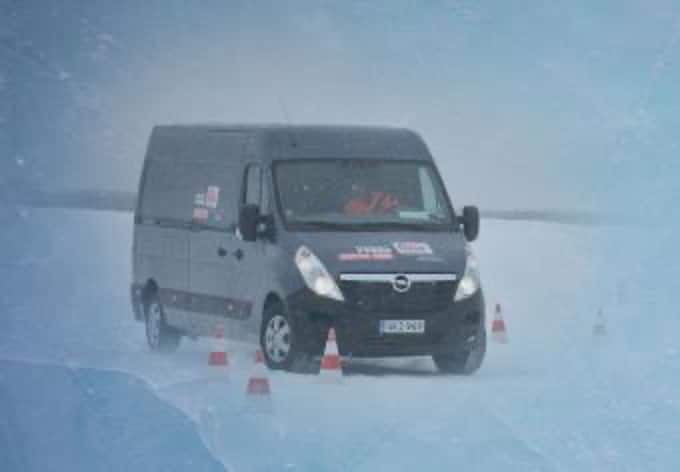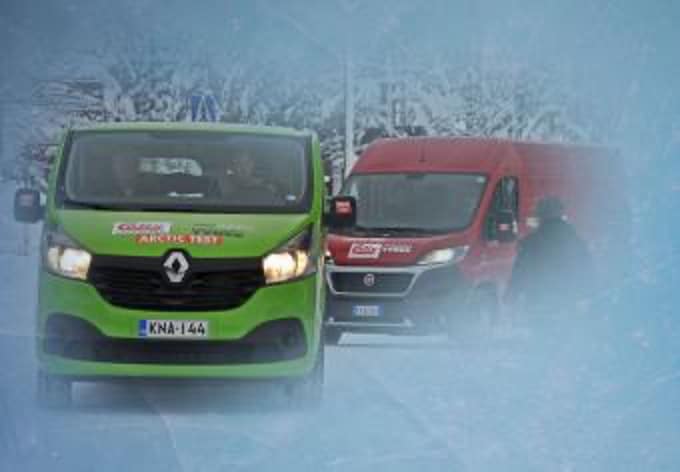Home »
Winter driving can be a bit of a challenge in the UK, but can you imagine what it is like to have to start your van when the temperature is -30C and below? Diesel freezes and engine oil that is too thick to pump, vans are almost useless in the harsh wilderness of Scandinavia. That is why each year Finnish magazine Auto Teknikka Ja Kuljetus and a bunch of journalists from across Europe put a selection of vans to the sword in the ice and snow of the Arctic Van Test – two gruelling weeks of extreme evaluation into northern Finland to find out which van is best for snow and ice.
This year the test was split in two groups with medium-sized vans and larger 3.5-tonners. The mid-sized group of Ford Transit Custom, Mercedes-Benz Vito and Renault Trafic were joined by Fiat’s new Ducato, Vauxhall’s Movano and the Ford Transit at the start point in Mäntsälä, 60km north-east of Helsinki. Here the vehicles were prepared for their Arctic adventure and fitted with extreme winter tyres by Nokian, filled with Neste Oil and wired up with Driveco tracking systems. Then, loaded with test weights, the vans were weighed and measured to access the functionality of the cargo spaces.
Agility and reversing
Testing began by examining the turning circles of each vehicle as they commonly differ from the manufactures’ figures when driving on snowy ground with winter tyres. The Vauxhall Movano showed itself to have the biggest difference to manufacture’s figure, while the Ford Transit Custom and Fiat Ducato came closest. Unusually, the chart shows that turning circles also differ whether the vehicle is turning left or right.
See how the size of the vans compare in our Renault Trafic dimensions, Ford Transit dimensions, Ford Transit Custom dimensions and Fiat Ducato dimensions guides.
Next, reversing was tested using a coned test track to simulate a narrow street and a gateway. Maneuverability obviously plays a large part in reversing, but visibility plays a big part too, and each of the big vans were more than up to the task with wing mirrors featuring separate wide-angled sections. Ford’s is the largest but has the smallest regular mirrors, nevertheless it was enough to see the rear quarters of the vehicle and its tyres. Fiat’s Ducato has rather small wide-angle mirrors but thank to electric controls the view is improved and scored highly as a result. The Vauxhall’s mirrors gave decent view despite smallish wide-angle mirrors, but the 4.3m wheelbase made it difficult to reverse the Vauxhall through the tight corners of the narrow icy street.
In the mid-sized group, the Renault Trafic scored the best points in the reversing category, edging out the Ford Transit Custom by a small margin thanks to the Trafic’s passenger sun visor mirror that improves wide-angled visibility.
A city battle
The city driving portion of the Arctic Van Test was conducted in the port town of Oulu, 600km north of the capital and on the edge of the Arctic Circle. Here testers would evaluate the accessibility to cabin, gearing, engine torque and performance, as well as the handling characteristics of each vehicle on snow and ice.
Competition in the city was very close, especially in the mid-sized group. Ford and Mercedes were judged to have the best accessibility to the cabin, with the Mercedes gaining the most points for front and side visibility. Less relevant to the Arctic weather, but a necessary requirement for any van was the internal storage, and Renault was judged to have the best solutions – it also received praise for the torque developed by the turbo-twin engine. Mercedes triumphed in the noise testing, recording the lowest cabin noise-levels.
Of the larger vans, the Ford Transit was deemed to have the best driving position and also the best visibility, but the Vauxhall shone thanks to its multiple compartments and its dash layout.
The Movano’s engine also impressed, with the new twin-turbo engine leading the Vauxhall van to the top spot in the city tests, where it also impressed on gearing and grip when on snow and ice.
The battle of the best
It was an unusual result in the 1-tonne category of the 2015 Arctic Van Test. For the first time ever in the 29-year history of the test, there was a three-way tie among the medium vans. If anything, this demonstrates just how capable all vans now are, and that each is more than fit for purpose, even in the most extreme environments.
Fiat made a breakthrough in the big van group, but the competition was extremely close. As the winner, it scored only one point more than the Ford, which came in in second place ahead of the Vauxhall.
As the exceptionally even competition in the Arctic Test this year shows, it is not difficult to choose a good van in 2015 regardless of whether you are multi-dropping in Manchester, or off-roading on snow and ice in Oulu.
Improved safety
When there's snow and ice its generally a good idea to have a computer watching your back. Traction control and electronic stability control systems are generally a good idea in winter conditions and were tested on the ice track tests at Pudasjärvi airport. Ford’s Transit Custom received the best test points in the medium van group, while the new front-wheel-drive Mercedes Vito was almost as good. Fiat and Ford scored highest in the large van group, but testers did comment that the Ford system was very restrictive and awkward at times.
Master of possibilities
Ford Transit 350 2.2 TDCi 155
Test points 207
The Ford Transit is the most adaptable of any of the vehicles on test, with a choice of front-wheel-drive, rear-wheel-drive and four-wheel-drive, it also has the underpinnings for any working environment.
Testers liked the vans improved storage – the Transit has increased its loadspace capacity by 10% over the old model – and particularly liked the large side door. It coped well on the slippery winter roads, and with equipment like heated windscreens as standard, it’s an ideal specification for northern Finland. As with the smaller Transit Custom, testers also commented on the “button jungle”, and as a rear-wheel drive model, the loading height was particularly high.

Based on a Master
Vauxhall Movano 2.3 CDTI 136 BiTurbo
Test points 202
Because of its French heritage – the Vauxhall is a shared product with the Renault Master – the Movano’s interior performs well for functionality with plenty of room for computers, papers, pens and other equipment. The Movano received a lot of praise for its new engine, but testers were less enamoured with the upright driving position and overly zealous electronic stability control, which cut in repeatedly and occasionally unnecessarily in the snow and ice conditions.

Winner on the open roads
Ford Transit Custom 310 2.2TDCi 125 L1H1
Test points 209
Ford Transit Custom turned out to be universally good in all types of driving. It ran smoothly and comfortably on the frozen roads and performed superbly in the cities as well. The shape of the rear loadspace was thought to be a bit weaker than the competitors have, while testers also commented that it takes a little time to get used to the dashboard’s “button jungle”. Long service intervals also appear to be one of Ford’s strengths, a boost for total cost of ownership and downtime.

Winner in logistics
Renault Trafic dCi 120 TwinTurbo L2H1
Test points 209
Renault received universal praise for the level of equipment in its van, and has stolen a march on its competitors by including telephone and tablet holders in its new Trafic. Testers noted that the van is full of little details that are “wise” and superior to its competition. The blind spot mirror, attached to co-driver’s sun visor, is a good example of this. The rear loadspace also impressed, thanks largely to the van’s ability to take a 4m-long length, thanks to the load through hatch under the passenger seat.

Winner in the City
Mercedes-Benz Vito 111CDI Medium
Test points 209
Mercedes-Benz Vito proved to be particularly competent in the city – partly due to having the easiest accessibility to the cabin of each of the vehicles in the test. However, the Vito’s mirrors were also judged to be the worst in the test group – which is a major negative when driving in cities. The Vito’s suspension was also evaluated as the best while driving on regular roads road, and was helped by the new front-wheel drive configuration now available in the range. Other negatives from the test included the engine’s awkwardness when driving at low rpm, and the narrowness of the cabin.
Read our Mercedes-Benz Vito review

Winner 2015
Fiat Ducato 3,5t 2.3 Multijet 150
Test points 208
The Ducato received large amounts of praise from its fuel economy and acceleration during the test. Its engine is among the best in the sector. Storage is also impressive, with plenty of room for small objects in the cab making the Ducato a real mobile office. Negatives noted by the testers included poor front visbility and limited space for passenger knees in cabin.

The Ducato cab is a real mobile office
Read the Fiat Ducato review here